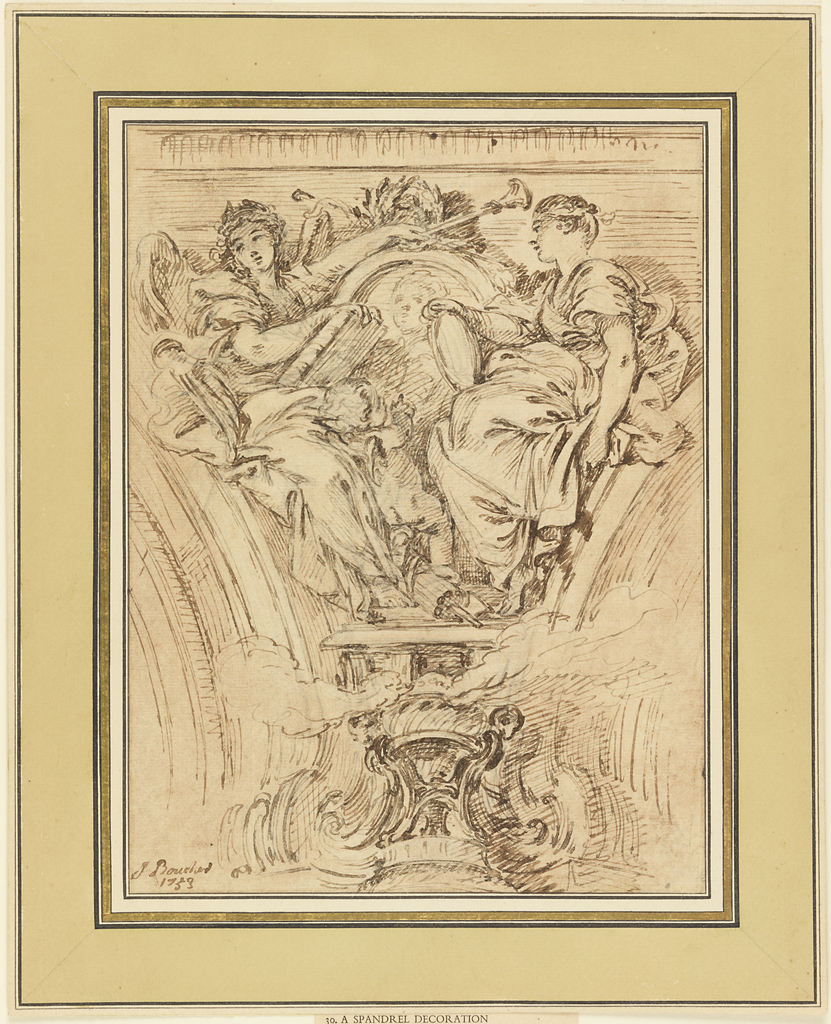This drawing is a design for a spandrel, the roughly triangular space between the left or right exterior curve of an arch, by the French academician and painter François Boucher. The drawing is executed with black chalk, pen, brown ink and wash and represents the personification of truth and fame honoring Louis XV. In the lower left corner, Boucher has signed and dated the drawing.
Two female allegories are seated on either edge of the spandrel. The left is the personification of Fame, identified by her trumpet and laurel crown. However, as she is holding a book in her lap, she may also be interpreted as Clio, the muse of history. Under her feet is fasces, a bundle of lector’s rods which symbolizes leadership. [These allegories were appropriated and adapted from publications such as Cesare Ripa’s Iconologia (first published in 1593 without illustrations, with many later revised and expanded editions), which set the standard for iconological traditions.] To the right is the personification of Truth, as signaled by the mirror in her hands. A putto, in between the two allegories, points toward a portrait of Louis XV and an incense burner in the foreground billows out smoke.
The trope of Clio honoring the king is echoed by other decorations in royal residences such as in Antoine Coysevox’s stucco relief of Louis XIV after Charles Le Brun in Salon de la Guerre (War Room) in Versailles. In this relief sculpture, Louis XIV is honored by Fame while Clio, in the lower dado, writes the history of the Sun King’s reign. The inclusion of Louis XV’s portrait in Boucher’s design locates this alongside other of his royal commissions and related projects from this period. In 1753, Boucher was charged with the decoration of the Salle du Conseil (Council Chamber) at Fontainebleau, exhibiting his painted designs for them at the Salon of 1753. Another connection can be made to Boucher’s designs for the Histoire de Louis XV par médailles, an unfinished project begun in 1753, under the direction of Charles-Nicolas Cochin I, which sought to illustrate events from the life of Louis XV through medals. Boucher’s drawing for this, engraved by Le Cars in 1757, illustrated the allegory of the education of King Louis XV in which a female personification of Fame also hovers in-between the two medals.
Boucher was an incredibly prolific draughtsman whose drawings were often reproduced and disseminated through prints. Still, this spandrel design was not made to be engraved but was likely a means for him to exercise his imagination. In fact, pen and ink drawings are not common in his vast graphic portfolio, and ornamental decorations executed in this media are often attributed to the early days in his career. By contrast, this drawing was produced during a fruitful period in his career and is a marker of the collision and collusion between Boucher’s diverse artistic productions.
Cabelle Ahn is a graduate intern in the Department of Drawings, Prints and Graphic Design at the Cooper Hewitt, Smithsonian Design Museum. She received her MA in Art History from the Courtauld Institute of Art and is currently studying eighteenth century decorative arts at the Bard Graduate Center.
